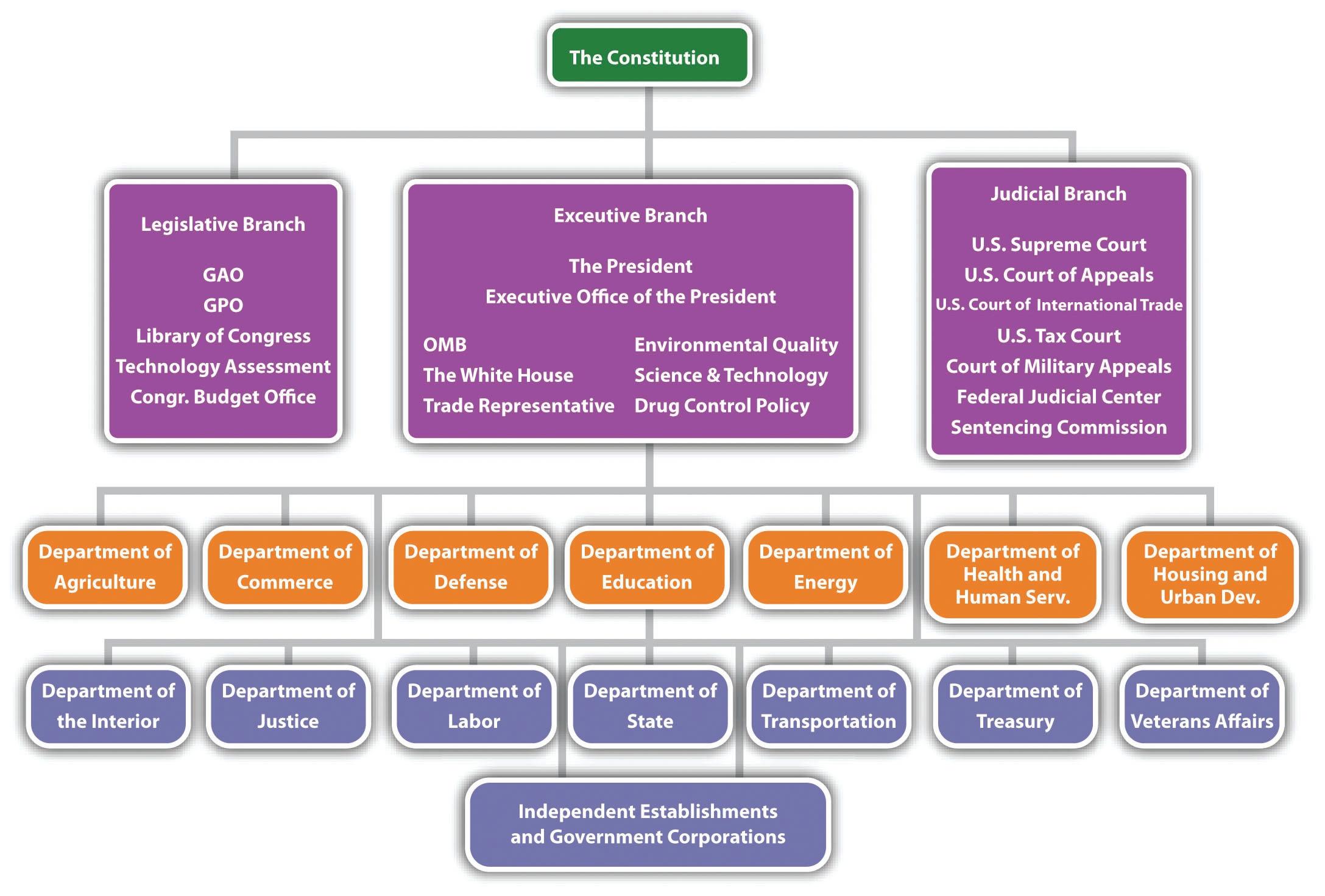After reading this chapter, you should be able to understand and articulate answers to the following questions:
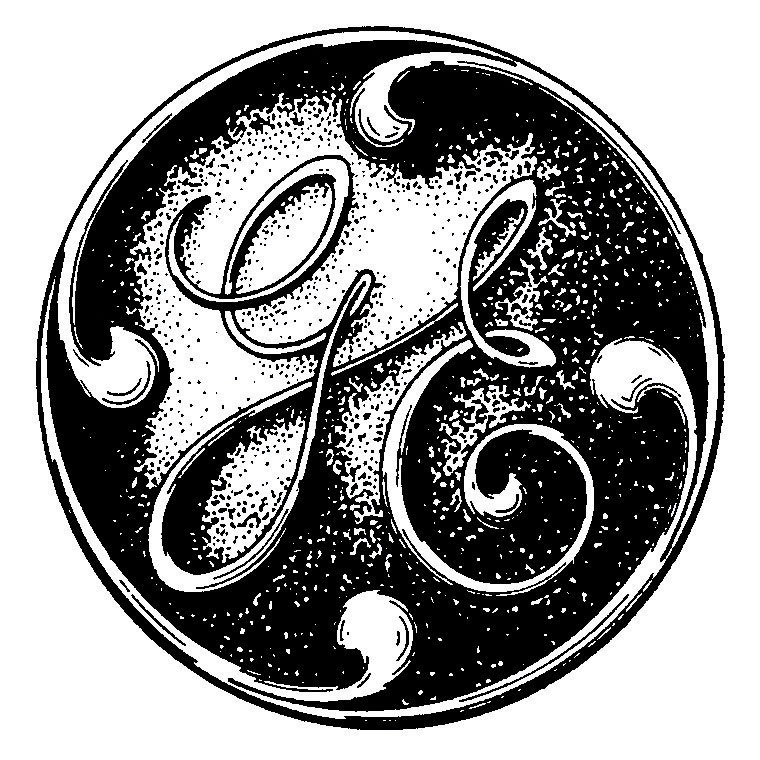
General Electric’s logo has changed little since its creation in the 1890s, but the company has grown to become the sixth largest in the United States.
Image courtesy of The General Electric Company, http://en.wikipedia.org/wiki/File:Early_General_Electric_logo_1899.png.
In February 2011, General Electric (GE) reached an agreement to acquire the well-support division of John Wood Group PLC for $2.8 billion. This was GE’s third acquisition of a company that provides services to oil wells in only five months. In October 2010, GE added the deepwater exploration capabilities of Wellstream Holdings PLC for $1.3 billion. In December 2010, part and equipment maker Dresser was acquired for $3 billion. By spending more than $7 billion on these acquisitions, GE executives made it clear that they had big plans within the oil well services business.
While many executives would struggle to integrate three new companies into their firms, experts expected GE’s leaders to smoothly execute the transitions. In describing the acquisition of John Wood Group PLC, for example, one Wall Street analyst noted, “This is a nice bolt-on deal for GE.”Layne, R. 2011, February 14. GE agrees to buy $2.8 billion oil-service unit; shares surge. Bloomsberg Businessweek. Retrieved from http://www.businessweek.com/news/2011-02-14/ge-agrees-to-buy-2-8-billion-oil-service-unit-shares-surge.html In other words, this analyst believed that John Wood Group PLC could be seamlessly added to GE’s corporate empire. The way that GE was organized fueled this belief.
GE’s organizational structure includes six divisions, each devoted to specific product categories: (1) Energy (the most profitable division), (2) Capital (the largest division), (3) Home & Business Solutions, (4) Healthcare, (5) Aviation, and (6) Transportation. Within the Energy division, there are three subdivisions: (1) Oil & Gas, (2) Power & Water, and (3) Energy Services. Rather than having the entire organization involved with integrating John Wood Group PLC, Wellstream Holdings PLC, and Dresser into GE, these three newly acquired companies would simply be added to the Oil & Gas subdivisions within the Energy division.
In addition to the six product divisions, GE also had a division devoted to Global Growth & Operations. This division was responsible for all sales of GE products and services outside the United States. The Global Growth & Operations division was very important to GE’s future. Indeed, GE’s CEO Jeffrey Immelt expected that countries other than the United States will account for 60 percent of GE’s sales in the future, up from 53 percent in 2010. To maximize GE’s ability to respond to local needs, the Global Growth & Operations was further divided into twelve geographic regions: China, India, Southeast Asia, Latin/South America, Russia, Canada, Australia, the Middle East, Africa, Germany, Europe, and Japan.GE names vice chairman John Rice to lead GE Global Growth & Operations [Press release]. 2010, November 8. GE website. Retrieved from http://www.genewscenter.com/ Press-Releases/GE-Names-Vice-Chairman-John-Rice-to-Lead-GE-Global-Growth-Operations-2c8a.aspx
Finally, like many large companies, GE also provided some centralized services to support all its units. These support areas included public relations, business development, legal, global research, human resources, and finance. By having entire units of the organization devoted to these functional areas, GE hoped not only to minimize expenses but also to create consistency across divisions.
Growing concerns about the environmental effects of drilling, for example, made it likely that GE’s oil well services operations would need the help of GE’s public relations and legal departments in the future. Other important questions about GE’s acquisitions remained open as well. In particular, would the organizational cultures of John Wood Group PLC, Wellstream Holdings PLC, and Dresser mesh with the culture of GE? Most acquisitions in the business world fail to deliver the results that executives expect, and the incompatibility of organizational cultures is one reason why.
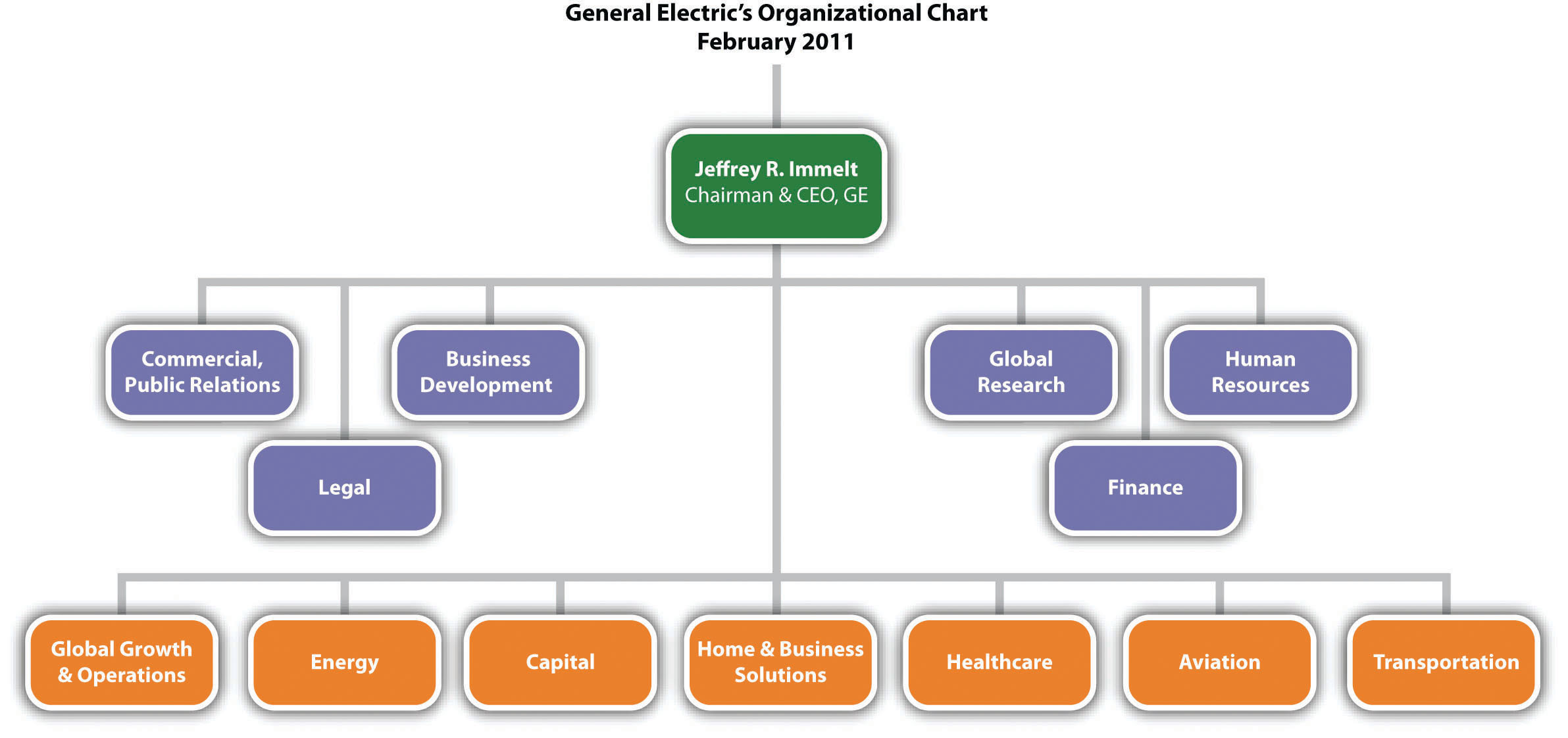
GE fits a dizzying array of businesses into a relatively simple organizational chart.
Adapted from company document posted at http://www.ge.com/pdf/company/ge_organization_chart.pdf
The word executing used in this chapter’s title has two distinct meanings. These meanings were cleverly intertwined in a quip by John McKay. McKay had the misfortune to be the head coach of a hapless professional football team. In one game, McKay’s offensive unit played particularly poorly. When McKay was asked after the game what he thought of his offensive unit’s execution, he wryly responded, “I am in favor of it.”
In the context of business, execution refers to how well a firm such as GE implements the strategies that executives create for it. This involves the creation and operation of both an appropriate organizational structure and an appropriate organizational control processes. Executives who skillfully orchestrate structure and control are likely to lead their firms to greater levels of success. In contrast, those executives who fail to do so are likely to be viewed by stakeholders such as employees and owners in much the same way Coach McKay viewed his offense: as worthy of execution.
General Electric (GE) offers a dizzying array of products and services, including lightbulbs, jet engines, and loans. One way that GE could produce its lightbulbs would be to have individual employees work on one lightbulb at a time from start to finish. This would be very inefficient, however, so GE and most other organizations avoid this approach. Instead, organizations rely on division of laborA process of splitting up a task into a series of smaller tasks, each of which is performed by a specialist. when creating their products (Figure 9.1 "The Building Blocks of Organizational Structure"). Division of labor is a process of splitting up a task (such as the creation of lightbulbs) into a series of smaller tasks, each of which is performed by a specialist.
Figure 9.2 Hierarchy of Authority

Reprinted with permission from [citation redacted per publisher request].
The leaders at the top of organizations have long known that division of labor can improve efficiency. Thousands of years ago, for example, Moses’s creation of a hierarchy of authority by delegating responsibility to other judges offered perhaps the earliest known example (Figure 9.2 "Hierarchy of Authority"). In the eighteenth century, Adam Smith’s book The Wealth of Nations quantified the tremendous advantages that division of labor offered for a pin factory. If a worker performed all the various steps involved in making pins himself, he could make about twenty pins per day. By breaking the process into multiple steps, however, ten workers could make forty-eight thousand pins a day. In other words, the pin factory was a staggering 240 times more productive than it would have been without relying on division of labor. In the early twentieth century, Smith’s ideas strongly influenced Henry Ford and other industrial pioneers who sought to create efficient organizations.
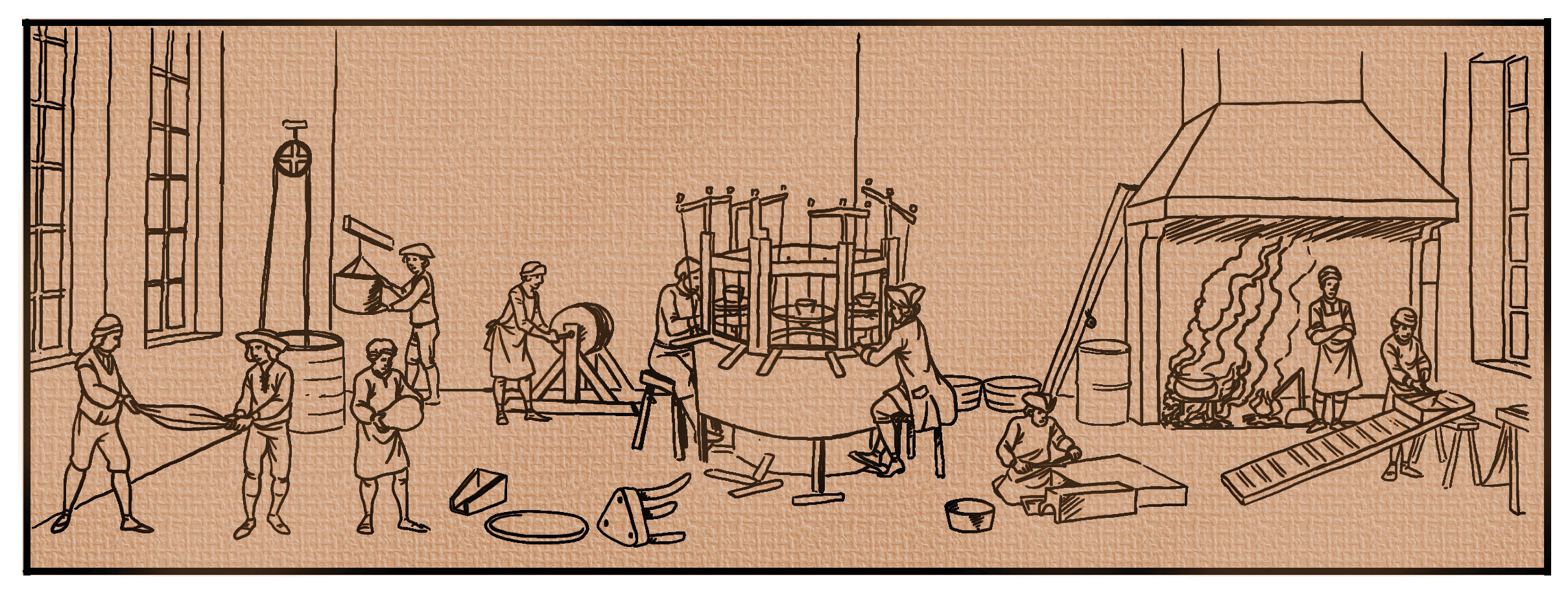
Division of labor allowed eighteenth-century pin factories to dramatically increase their efficiency.
Image courtesy of [citation redacted per publisher request].
While division of labor fuels efficiency, it also creates a challenge—figuring out how to coordinate different tasks and the people who perform them. The solution is organizational structureHow tasks are assigned and grouped together with formal reporting relationships., which is defined as how tasks are assigned and grouped together with formal reporting relationships. Creating a structure that effectively coordinates a firm’s activities increases the firm’s likelihood of success. Meanwhile, a structure that does not match well with a firm’s needs undermines the firm’s chances of prosperity.
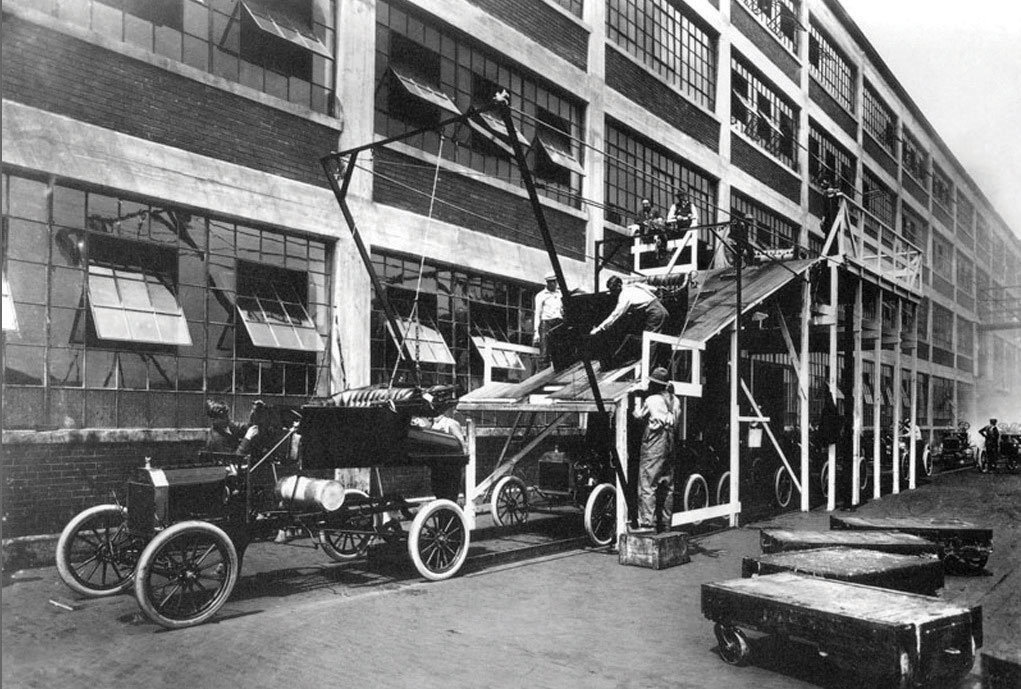
Division of labor was central to Henry Ford’s development of assembly lines in his automobile factory. Ford noted, “Nothing is particularly hard if you divide it into small jobs.”
Image courtesy of the Ford Company, http://en.wikipedia.org/wiki/File:A-line1913.jpg.
Most organizations use a diagram called an organizational chartA diagram that depicts how firms’ structures are built using two basic building blocks: vertical linkages and horizontal linkages. to depict their structure. These organizational charts show how firms’ structures are built using two basic building blocks: vertical linkages and horizontal linkages. Vertical linkagesRelationships within an organizational structure that show the lines of responsibility through which a supervisor delegates authority to subordinates, oversees their activities, evaluates their performance, and guides them toward improvement when necessary. tie supervisors and subordinates together. These linkages show the lines of responsibility through which a supervisor delegates authority to subordinates, oversees their activities, evaluates their performance, and guides them toward improvement when necessary. Every supervisor except for the person at the very top of the organization chart also serves as a subordinate to someone else. In the typical business school, for example, a department chair supervises a set of professors. The department chair in turn is a subordinate of the dean.
Most executives rely on the unity of commandThe principle that each person within an organization should only report directly to one supervisor. principle when mapping out the vertical linkages in an organizational structure. This principle states that each person should only report directly to one supervisor. If employees have multiple bosses, they may receive conflicting guidance about how to do their jobs. The unity of command principle helps organizations to avoid such confusion. In the case of General Electric, for example, the head of the Energy division reports only to the chief executive officer. If problems were to arise with executing the strategic move discussed in this chapter’s opening vignette—joining the John Wood Group PLC with GE’s Energy division—the head of the Energy division reports would look to the chief executive officer for guidance.
Horizontal linkagesRelationships between equals in an organization. are relationships between equals in an organization. Often these linkages are called committees, task forces, or teams. Horizontal linkages are important when close coordination is needed across different segments of an organization. For example, most business schools revise their undergraduate curriculum every five or so years to ensure that students are receiving an education that matches the needs of current business conditions. Typically, a committee consisting of at least one professor from every academic area (such as management, marketing, accounting, and finance) will be appointed to perform this task. This approach helps ensure that all aspects of business are represented appropriately in the new curriculum.
Organic grocery store chain Whole Foods Market is a company that relies heavily on horizontal linkages. As noted on their website, “At Whole Foods Market we recognize the importance of smaller tribal groupings to maximize familiarity and trust. We organize our stores and company into a variety of interlocking teams. Most teams have between 6 and 100 Team Members and the larger teams are divided further into a variety of sub-teams. The leaders of each team are also members of the Store Leadership Team and the Store Team Leaders are members of the Regional Leadership Team. This interlocking team structure continues all the way upwards to the Executive Team at the highest level of the company.”John Mackey’s blog. 2010, March 9. Creating the high trust organization [Web blog post]. Retrieved from http://www2.wholefoodsmarket.com/blogs/jmackey/2010/03/09/creating-the-high-trust-organization/ This emphasis on teams is intended to develop trust throughout the organization, as well as to make full use of the talents and creativity possessed by every employee.
Informal linkagesUnofficial relationships such as personal friendships, rivalries, and politics. refer to unofficial relationships such as personal friendships, rivalries, and politics. In the long-running comedy series The Simpsons, Homer Simpson is a low-level—and very low-performing—employee at a nuclear power plant. In one episode, Homer gains power and influence with the plant’s owner, Montgomery Burns, which far exceeds Homer’s meager position in the organization chart, because Mr. Burns desperately wants to be a member of the bowling team that Homer captains. Homer tries to use his newfound influence for his own personal gain and naturally the organization as a whole suffers. Informal linkages such as this one do not appear in organizational charts, but they nevertheless can have (and often do have) a significant influence on how firms operate.
Within most firms, executives rely on vertical and horizontal linkages to create a structure that they hope will match the needs of their firm’s strategy. Four types of structures are available to executives: (1) simple, (2) functional, (3) multidivisional, and (4) matrix (Figure 9.3 "Common Organizational Structures"). Like snowflakes, however, no two organizational structures are exactly alike. When creating a structure for their firm, executives will take one of these types and adapt it to fit the firm’s unique circumstances. As they do this, executives must realize that the choice of structure will influences their firm’s strategy in the future. Once a structure is created, it constrains future strategic moves. If a firm’s structure is designed to maximize efficiency, for example, the firm may lack the flexibility needed to react quickly to exploit new opportunities.
Many organizations start out with a simple structureAn arrangement that does not rely on formal systems of division of labor, often because one person performs all the tasks that the organization needs to accomplish.. In this type of structure, an organizational chart is usually not needed. Simple structures do not rely on formal systems of division of labor (Figure 9.4 "Simple Structure"). If the firm is a sole proprietorship, one person performs all the tasks the organization needs to accomplish. For example, on the TV series The Simpsons, both bar owner Moe Szyslak and the Comic Book Guy are shown handling all aspects of their respective businesses.
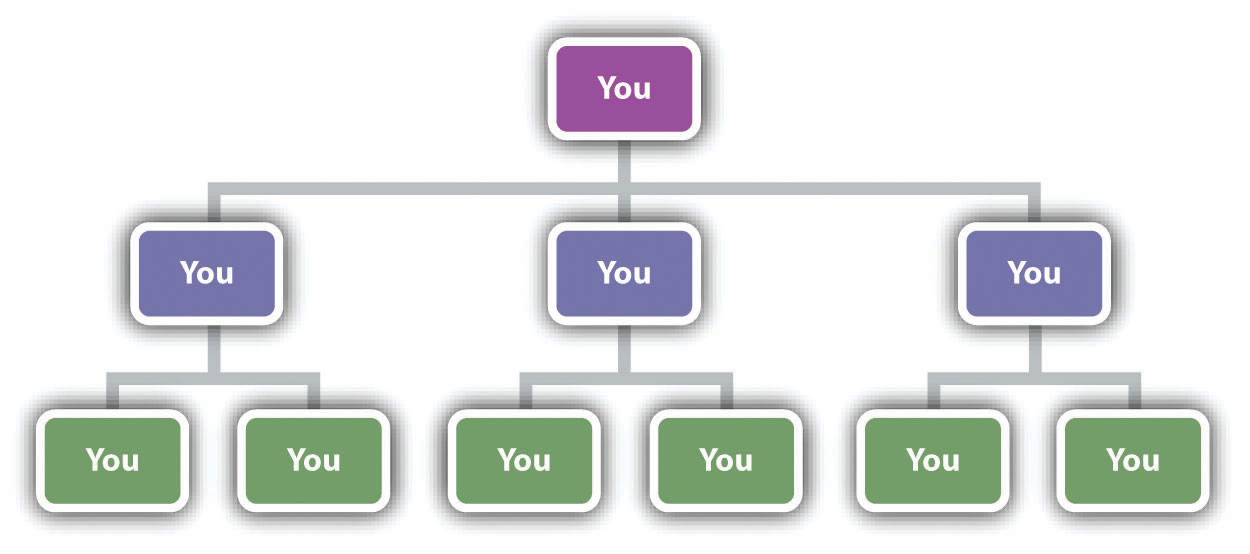
There is a good reason most sole proprietors do not bother creating formal organizational charts.
If the firm consists of more than one person, tasks tend to be distributed among them in an informal manner rather than each person developing a narrow area of specialization. In a family-run restaurant or bed and breakfast, for example, each person must contribute as needed to tasks, such as cleaning restrooms, food preparation, and serving guests (hopefully not in that order). Meanwhile, strategic decision making in a simple structure tends to be highly centralized. Indeed, often the owner of the firm makes all the important decisions. Because there is little emphasis on hierarchy within a simple structure, organizations that use this type of structure tend to have very few rules and regulations. The process of evaluating and rewarding employees’ performance also tends to be informal.
The informality of simple structures creates both advantages and disadvantages. On the plus side, the flexibility offered by simple structures encourages employees’ creativity and individualism. Informality has potential negative aspects, too. Important tasks may be ignored if no one person is specifically assigned accountability for them. A lack of clear guidance from the top of the organization can create confusion for employees, undermine their motivation, and make them dissatisfied with their jobs. Thus when relying on a simple structure, the owner of a firm must be sure to communicate often and openly with employees.
As a small organization grows, the person in charge of it often finds that a simple structure is no longer adequate to meet the organization’s needs. Organizations become more complex as they grow, and this can require more formal division of labor and a strong emphasis on hierarchy and vertical links. In many cases, these firms evolve from using a simple structure to relying on a functional structureAn organizational arrangement whereby employees are divided into departments that each handle activities related to an area of the business, such as marketing, production, human resources, information technology, and customer service..
Within a functional structure, employees are divided into departments that each handle activities related to a functional area of the business, such as marketing, production, human resources, information technology, and customer service (Figure 9.5 "Functional Structure"). Each of these five areas would be headed up by a manager who coordinates all activities related to her functional area. Everyone in a company that works on marketing the company’s products, for example, would report to the manager of the marketing department. The marketing managers and the managers in charge of the other four areas in turn would report to the chief executive officer.

An example of a functional structure
Reproduced with permission from [citation redacted per publisher request].
Using a functional structure creates advantages and disadvantages. An important benefit of adopting a functional structure is that each person tends to learn a great deal about his or her particular function. By being placed in a department that consists entirely of marketing professionals, an individual has a great opportunity to become an expert in marketing. Thus a functional structure tends to create highly skilled specialists. Second, grouping everyone that serves a particular function into one department tends to keep costs low and to create efficiency. Also, because all the people in a particular department share the same background training, they tend to get along with one another. In other words, conflicts within departments are relatively rare.
Using a functional structure also has a significant downside: executing strategic changes can be very slow when compared with other structures. Suppose, for example, that a textbook publisher decides to introduce a new form of textbook that includes “scratch and sniff” photos that let students smell various products in addition to reading about them. If the publisher relies on a simple structure, the leader of the firm can simply assign someone to shepherd this unique new product through all aspects of the publication process.
If the publisher is organized using a functional structure, however, every department in the organization will have to be intimately involved in the creation of the new textbooks. Because the new product lies outside each department’s routines, it may become lost in the proverbial shuffle. And unfortunately for the books’ authors, the publication process will be halted whenever a functional area does not live up to its responsibilities in a timely manner. More generally, because functional structures are slow to execute change, they tend to work best for organizations that offer narrow and stable product lines.
The specific functional departments that appear in an organizational chart vary across organizations that use functional structures. In the example offered earlier in this section, a firm was divided into five functional areas: (1) marketing, (2) production, (3) human resources, (4) information technology, and (5) customer service. In the TV show The Office, a different approach to a functional structure is used at the Scranton, Pennsylvania, branch of Dunder Mifflin. As of 2009, the branch was divided into six functional areas: (1) sales, (2) warehouse, (3) quality control, (4) customer service, (5) human resources, and (6) accounting. A functional structure was a good fit for the branch at the time because its product line was limited to just selling office paper.
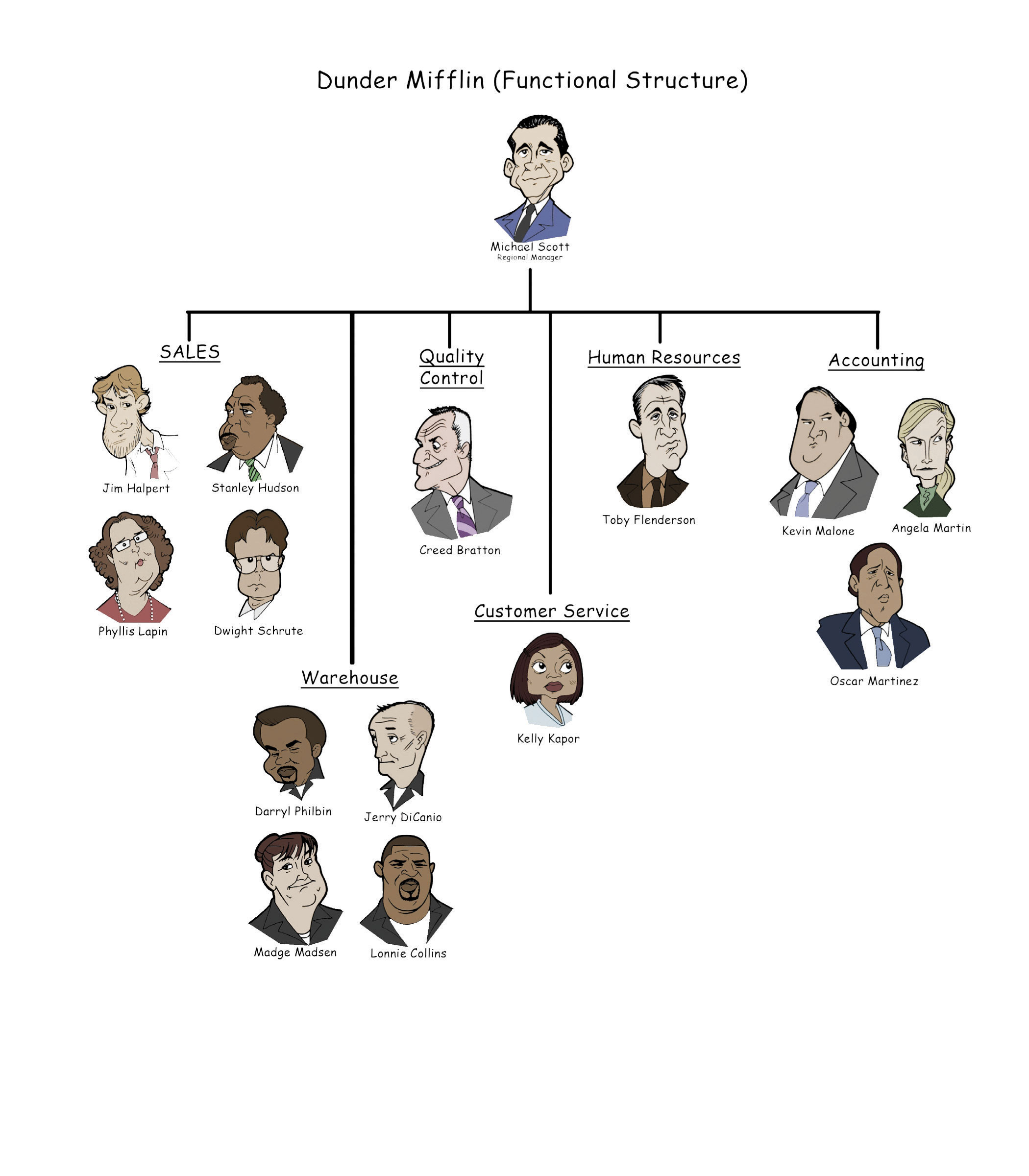
The Scranton branch of Dunder Mifflin may be a dysfunctional organization, but it relies on a functional structure.
Image courtesy of [citation redacted per publisher request].
Many organizations offer a wide variety of products and services. Some of these organizations sell their offerings across an array of geographic regions. These approaches require firms to be very responsive to customers’ needs. Yet, as noted, functional structures tend to be fairly slow to change. As a result, many firms abandon the use of a functional structure as their offerings expand. Often the new choice is a multidivisional structureAn organizational arrangement whereby employees are divided into departments based on product areas and/or geographic regions.. In this type of structure, employees are divided into departments based on product areas and/or geographic regions.
General Electric (GE) is an example of a company organized this way. As shown in the organization chart that accompanies this chapter’s opening vignette, most of the company’s employees belong to one of six product divisions (Energy, Capital, Home & Business Solutions, Health Care, Aviation, and Transportation) or to a division that is devoted to all GE’s operations outside the United States (Global Growth & Operations).
A big advantage of a multidivisional structure is that it allows a firm to act quickly. When GE makes a strategic move such as acquiring the well-support division of John Wood Group PLC, only the relevant division (in this case, Energy) needs to be involved in integrating the new unit into GE’s hierarchy. In contrast, if GE was organized using a functional structure, the transition would be much slower because all the divisions in the company would need to be involved. A multidivisional structure also helps an organization to better serve customers’ needs. In the summer of 2011, for example, GE’s Capital division started to make real-estate loans after exiting that market during the financial crisis of the late 2000s.Jacobius, A. 2011, July 25. GE Capital slowly moving back into lending waters. Pensions & Investments. Retrieved from http://www.pionline.com/article/20110725/PRINTSUB/110729949 Because one division of GE handles all the firm’s loans, the wisdom and skill needed to decide when to reenter real-estate lending was easily accessible.
Of course, empowering divisions to act quickly can backfire if people in those divisions take actions that do not fit with the company’s overall strategy. McDonald’s experienced this kind of situation in 2002. In particular, the French division of McDonald’s ran a surprising advertisement in a magazine called Femme Actuelle. The ad included a quote from a nutritionist that asserted children should not eat at a McDonald’s more than once per week. Executives at McDonald’s headquarters in suburban Chicago were concerned about the message sent to their customers, of course, and they made it clear that they strongly disagreed with the nutritionist.
Another downside of multidivisional structures is that they tend to be more costly to operate than functional structures. While a functional structure offers the opportunity to gain efficiency by having just one department handle all activities in an area, such as marketing, a firm using a multidivisional structure needs to have marketing units within each of its divisions. In GE’s case, for example, each of its seven divisions must develop marketing skills. Absorbing the extra expenses that are created reduces a firm’s profit margin.
GE’s organizational chart highlights a way that firms can reduce some of these expenses: the centralization of some functional services. As shown in the organizational chart, departments devoted to important aspects of public relations, business development, legal, global research, human resources, and finance are maintained centrally to provide services to the six product divisions and the geographic division. By consolidating some human resource activities in one location, for example, GE creates efficiency and saves money.
An additional benefit of such moves is that consistency is created across divisions. In 2011, for example, the Coca-Cola Company created an Office of Sustainability to coordinate sustainability initiatives across the entire company. Bea Perez was named Coca-Cola’s chief sustainability officer and was put in charge of the Office of Sustainability. At the time, Coca-Cola’s chief executive officer Muhtar Kent noted that Coca-Cola had “made significant progress with our sustainability initiatives, but our current approach needs focus and better integration.”McWilliams, J. 2011, May 19. Coca-Cola names Bea Perez chief sustainability officer. Atlantic-Journal Constitution. Retrieved from http://www.ajc.com/business/coca-cola-names-bea-951741.html In other words, a department devoted to creating consistency across Coca-Cola’s sustainability efforts was needed for Coca-Cola to meet its sustainability goals.
Within functional and multidivisional structures, vertical linkages between bosses and subordinates are the most elements. Matrix structuresAn organizational arrangement that relies heavily on cross-functional teams that each work on a different project., in contrast, rely heavily on horizontal relationships.This discussion of matrix structures is adapted from Ketchen, D. J., & Short, J. C. 2011. Separating fads from facts: Lessons from “the good, the fad, and the ugly.” Business Horizons, 54, 17–22. In particular, these structures create cross-functional teams that each work on a different project. This offers several benefits: maximizing the organization’s flexibility, enhancing communication across functional lines, and creating a spirit of teamwork and collaboration. A matrix structure can also help develop new managers. In particular, a person without managerial experience can be put in charge of a relatively small project as a test to see whether the person has a talent for leading others.
Using a matrix structure can create difficulties too. One concern is that using a matrix structure violates the unity of command principle because each employee is assigned multiple bosses. Specifically, any given individual reports to a functional area supervisor as well as one or more project supervisors. This creates confusion for employees because they are left unsure about who should be giving them direction. Violating the unity of command principle also creates opportunities for unsavory employees to avoid responsibility by claiming to each supervisor that a different supervisor is currently depending on their efforts.
The potential for conflicts arising between project managers within a matrix structure is another concern. Chances are that you have had some classes with professors who are excellent speakers while you have been forced to suffer through a semester of incomprehensible lectures in other classes. This mix of experiences reflects a fundamental reality of management: in any organization, some workers are more talented and motivated than others. Within a matrix structure, each project manager naturally will want the best people in the company assigned to her project because their boss evaluates these managers based on how well their projects perform. Because the best people are a scarce resource, infighting and politics can easily flare up around which people are assigned to each project.
Given these problems, not every organization is a good candidate to use a matrix structure. Organizations such as engineering and consulting firms that need to maximize their flexibility to service projects of limited duration can benefit from the use of a matrix. Matrix structures are also used to organize research and development departments within many large corporations. In each of these settings, the benefits of organizing around teams are so great that they often outweigh the risks of doing so.
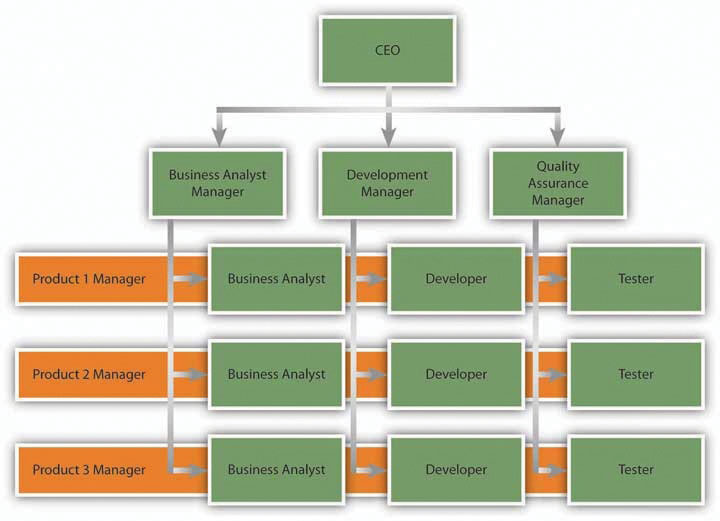
You won’t need to choose between a red pill and a blue pill within a matrix structure, but you will have multiple bosses.
Reproduced with permission from [citation redacted per publisher request].
Office Space
How much work can a man accomplish with eight bosses breathing down his neck? For Peter Gibbons, an employee at information technology firm Initech in the 1999 movie Office Space, the answer was zero. Initech’s use of a matrix structure meant that each employee had multiple bosses, each representing a different aspect of Initech’s business. High-tech firms often use matrix to gain the flexibility needed to manage multiple projects simultaneously. Successfully using a matrix structure requires excellent communication among various managers—however, excellence that Initech could not reach. When Gibbons forgot to put the appropriate cover sheet on his TPS report, each of his eight bosses—and a parade of his coworkers—admonished him. This fiasco and others led to Gibbons to become cynical about his job.
Simpler organizational structures can be equally frustrating. Joanna, a waitress at nearby restaurant Chotchkie’s, had only one manager—a stark contrast to Gibbons’s eight bosses. Unfortunately, Joanna’s manager had an unhealthy obsession with the “flair” (colorful buttons and pins) used by employees to enliven their uniforms. A series of mixed messages about the restaurant’s policy on flair led Joanna to emphatically proclaim—both verbally and nonverbally—her disdain for the manager. She then quit her job and stormed out of the restaurant.
Office Space illustrates the importance of organizational design decisions to an organization’s culture and to employees’ motivation levels. A matrix structure can facilitate resource sharing and collaboration but may also create complicated working relationships and impose excessive stress on employees. Chotchkie’s organizational structure involved simpler working relationships, but these relationships were strained beyond the breaking point by a manager’s eccentricities. In a more general sense, Office Space shows that all organizational structures involve a series of trade-offs that must be carefully managed.
Most organizational charts show clear divisions and boundaries between different units. The value of a much different approach was highlighted by former GE CEO Jack Welch when he created the term boundaryless organizationWhen the usual barriers between parts of the organization as well as barriers between the organization and others are removed.. A boundaryless organization is one that removes the usual barriers between parts of the organization as well as barriers between the organization and others.Askenas, R., Ulrich, D., Jick, T., & Kerr, S. 1995. The boundaryless organization: Breaking down the chains of organizational structure. San Francisco, CA: Jossey-Bass. Eliminating all internal and external barriers is not possible, of course, but making progress toward being boundaryless can help an organization become more flexible and responsive. One example is W.L. Gore, a maker of fabrics, medical implants, industrial sealants, filtration systems, and consumer products. This firm avoids organizational charts, management layers, and supervisors despite having approximately nine thousand employees across thirty countries. Rather than granting formal titles to certain people, leaders with W.L. Gore emerge based on performance and they attract followers to their ideas over time. As one employee noted, “We vote with our feet. If you call a meeting, and people show up, you’re a leader.”Hamel, G. 2007, September 27. What Google, Whole Foods do best. CNNMoney. Retrieved from http://money.cnn.com/2007/09/26/news/companies/management_hamel. fortune/index.htm

The boundaryless approach to structure embraced by W.L. Gore drives the kind of creative thinking that led to their most famous product, GORE-TEX.
Image courtesy of adifansnet, http://www.flickr.com/photos/adifans/3706215019.
An illustration of how removing barriers can be valuable has its roots in a very unfortunate event. During 2005’s Hurricane Katrina, rescue efforts were hampered by a lack of coordination between responders from the National Guard (who are controlled by state governments) and from active-duty military units (who are controlled by federal authorities). According to one National Guard officer, “It was just like a solid wall was between the two entities.”Elliott, D. 2011, July 3. New type of commander may avoid Katrina-like chaos. Yahoo! News. Retrieved from http://news.yahoo.com/type-commander-may-avoid-katrina-chaos-153 143508.html Efforts were needlessly duplicated in some geographic areas while attention to other areas was delayed or inadequate. For example, poor coordination caused the evacuation of thousands of people from the New Orleans Superdome to be delayed by a full day. The results were immense human suffering and numerous fatalities.

In 2005, boundaries between organizations hampered rescue efforts following Hurricane Katrina.
Image courtesy of Kyle Niemi, http://upload.wikimedia.org/wikipedia/commons/3/3d/KatrinaNewOrleansFlooded_edit2.jpg.
To avoid similar problems from arising in the future, barriers between the National Guard and active-duty military units are being bridged by special military officers called dual-status commanders. These individuals will be empowered to lead both types of units during a disaster recovery effort, helping to ensure that all areas receive the attention they need in a timely manner.
Creating an organizational structure is not a onetime activity. Executives must revisit an organization’s structure over time and make changes to it if certain danger signs arise. For example, a structure might need to be adjusted if decisions with the organization are being made too slowly or if the organization is performing poorly. Both these problems plagued Sears Holdings in 2008, leading executives to reorganize the company.
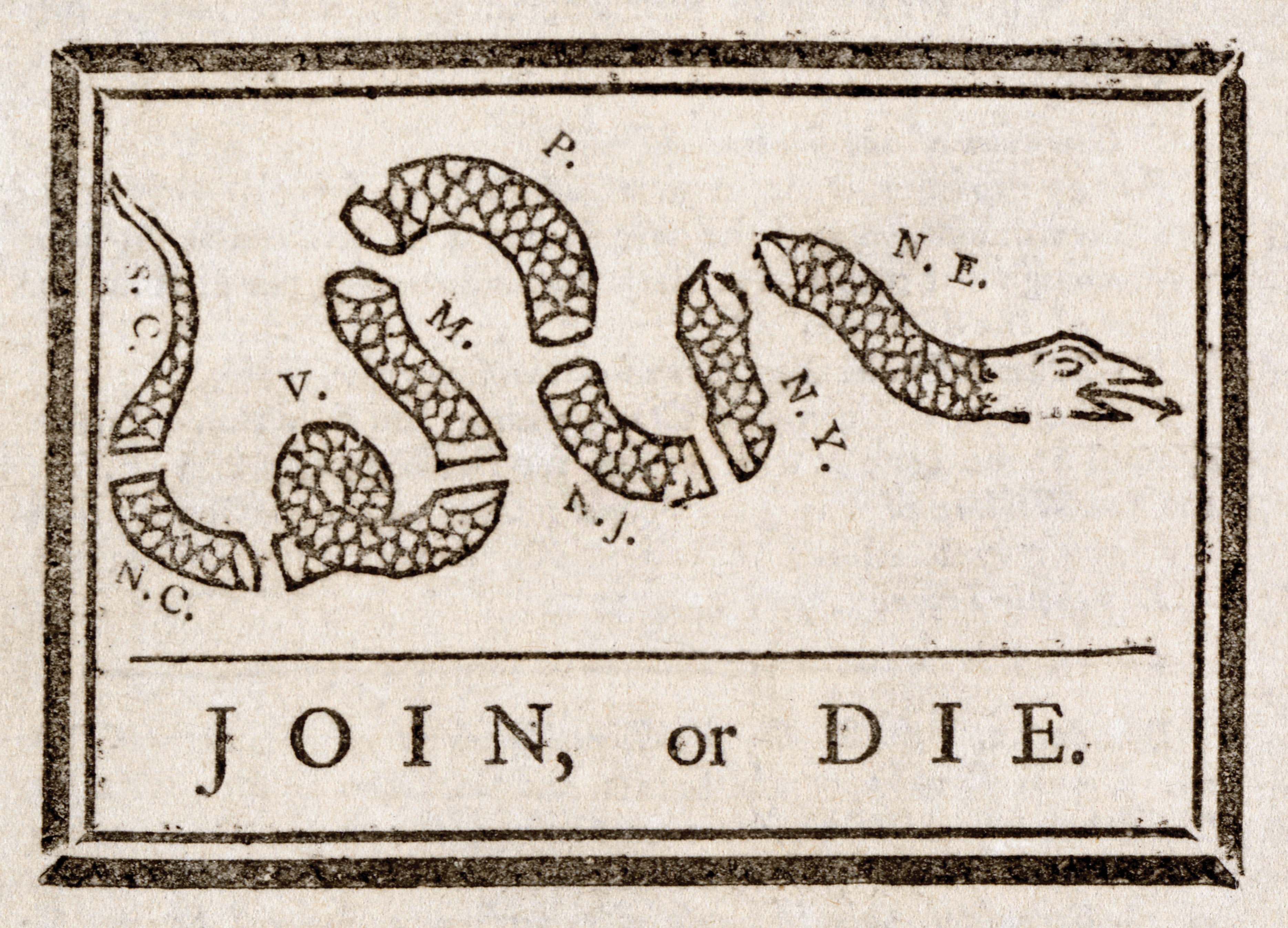
Although it was created to emphasize the need for unity among the American colonies, this famous 1754 graphic by Ben Franklin also illustrates a fundamental truth about structure: If the parts that make up a firm do not work together, the firm is likely to fail.
Image courtesy of Wikipedia, http://upload.wikimedia.org/wikipedia/commons/9/9c/Benjamin_Franklin_-_Join_or_Die.jpg.
Sears’s new structure organized the firm around five types of divisions: (1) operating businesses (such as clothing, appliances, and electronics), (2) support units (certain functional areas such as marketing and finance), (3) brands (which focus on nurturing the firm’s various brands such as Lands’ End, Joe Boxer, Craftsman, and Kenmore), (4) online, and (5) real estate. At the time, Sears’s chairman Edward S. Lampert noted that “by creating smaller focused teams that are clearly responsible for their units, we [will] increase autonomy and accountability, create greater ownership and enable faster, better decisions.”Sears restructures business units. Retail Net. Retrieved from http://www.retailnet.com /story.cfm?ID=41613. Unfortunately, structural changes cannot cure all a company’s ills. As of July 2011, Sears’s stock was worth just over half what it had been worth five years earlier.
Sometimes structures become too complex and need to be simplified. Many observers believe that this description fits Cisco. The company’s CEO, John Chambers, has moved Cisco away from a hierarchical emphasis toward a focus on horizontal linkages. As of late 2009, Cisco had four types of such linkages. For any given project, a small team of people reported to one of forty-seven boards. The boards averaged fourteen members each. Forty-three of these boards each reported to one of twelve councils. Each council also averaged fourteen members. The councils reported to an operating committee consisting of Chambers and fifteen other top executives. Four of the forty-seven boards bypassed the councils and reported directly to the operating committee. These arrangements are so complex and time consuming that some top executives spend 30 percent of their work hours serving on more than ten of the boards, councils, and the operating committee.
Because it competes in fast-changing high-tech markets, Cisco needs to be able to make competitive moves quickly. The firm’s complex structural arrangements are preventing this. In late 2007, Hewlett-Packard (HP) started promoting a warranty service that provides free support and upgrades within the computer network switches market. Because Cisco’s response to this initiative had to work its way through multiple committees, the firm did not take action until April 2009. During the delay, Cisco’s share of the market dropped as customers embraced HP’s warranty. This problem and others created by Cisco’s overly complex structure were so severe that one columnist wondered aloud “has Cisco’s John Chambers lost his mind?”Blodget, H. 2009, August 6. Has Cisco’s John Chambers lost his mind? Business Insider. Retrieved from http://www.businessinsider.com/henry-blodget-has-ciscos-john- chambers-lost-his-mind-2009-8 In the summer of 2011, Chambers reversed course and decided to return Cisco to a more traditional structure while reducing the firm’s workforce by 9 percent. Time will tell whether these structural changes will boost Cisco’s stock price, which remained flat between 2006 and mid-2011.
In addition to creating an appropriate organizational structure, effectively executing strategy depends on the skillful use of organizational control systems. Executives create strategies to try to achieve their organization’s vision, mission, and goals. Organizational control systemsAllow executives to track how well the organization is performing, identify areas of concern, and then take action to address the concerns. allow executives to track how well the organization is performing, identify areas of concern, and then take action to address the concerns. Three basic types of control systems are available to executives: (1) output control, (2) behavioral control, and (3) clan control. Different organizations emphasize different types of control, but most organizations use a mix of all three types.
Output controlA focus on measurable results within an organization. focuses on measurable results within an organization. Examples from the business world include the number of hits a website receives per day, the number of microwave ovens an assembly line produces per week, and the number of vehicles a car salesman sells per month (Figure 9.6 "Output Controls"). In each of these cases, executives must decide what level of performance is acceptable, communicate expectations to the relevant employees, track whether performance meets expectations, and then make any needed changes. In an ironic example, a group of post office workers in Pensacola, Florida, were once disappointed to learn that their paychecks had been lost—by the US Postal Service! The corrective action was simple: they started receiving their pay via direct deposit rather than through the mail.
Many times the stakes are much higher. In early 2011, Delta Air Lines was forced to face some facts as part of its use of output control. Data gathered by the federal government revealed that only 77.4 percent of Delta’s flights had arrived on time during 2010. This performance led Delta to rank dead last among the major US airlines and fifteenth out of eighteen total carriers.Yamanouchi, K. 2011, February 10. Delta ranks near bottom in on-time performance. Atlanta-Journal Constitution. Retrieved from http://www.ajc.com/business/delta-ranks-near-bottom-834380.html In response, Delta took important corrective steps. In particular, the airline added to its ability to service airplanes and provided more customer service training for its employees. Because some delays are inevitable, Delta also announced plans to staff a Twitter account called Delta Assist around the clock to help passengers whose flights are delayed. These changes and others paid off. For the second quarter of 2011, Delta enjoyed a $198 million profit, despite having to absorb a $1 billion increase in its fuel costs due to rising prices.Yamanouchi, K. 2011, July 27. Delta has $198 million profit, says 2,000 took buyouts. Atlanta-Journal Constitution. Retrieved from http://www.ajc.com/business/delta-has-198-million-1050461.html
Output control also plays a big part in the college experience. For example, test scores and grade point averages are good examples of output measures. If you perform badly on a test, you might take corrective action by studying harder or by studying in a group for the next test. At most colleges and universities, a student is put on academic probation when his grade point average drops below a certain level. If the student’s performance does not improve, he may be removed from his major and even dismissed. On the positive side, output measures can trigger rewards too. A very high grade point average can lead to placement on the dean’s list and graduating with honors.

While most scholarships require a high GPA, comedian David Letterman created a scholarship for a “C” student at Ball State University. Ball State later named a new communications and media building after its very famous alumnus.
Image courtesy of Kyle Flood, http://upload.wikimedia.org/wikipedia/commons/e/eb/David_Letterman_building.jpg.
While output control focuses on results, behavioral controlA focus on specifying the actions that ultimately lead to results. focuses on controlling the actions that ultimately lead to results. In particular, various rules and procedures are used to standardize or to dictate behavior (Figure 9.7 "Behavioral Controls"). In most states, for example, signs are posted in restaurant bathrooms reminding employees that they must wash their hands before returning to work. The dress codes that are enforced within many organizations are another example of behavioral control. To try to prevent employee theft, many firms have a rule that requires checks to be signed by two people. And in a somewhat bizarre example, some automobile factories dictate to workers how many minutes they can spend in restrooms during their work shift.
Behavioral control also plays a significant role in the college experience. An illustrative (although perhaps unpleasant) example is penalizing students for not attending class. Professors grade attendance to dictate students’ behavior; specifically, to force students to attend class. Meanwhile, if you were to suggest that a rule should be created to force professors to update their lectures at least once every five years, we would not disagree with you.
Outside the classroom, behavioral control is a major factor within college athletic programs. The National Collegiate Athletic Association (NCAA) governs college athletics using a huge set of rules, policies, and procedures. The NCAA’s rulebook on behavior is so complex that virtually all coaches violate its rules at one time or another. Critics suggest that the behavioral controls instituted by the NCAA have reached an absurd level. Nevertheless, some degree of behavioral control is needed within virtually all organizations.
Creating an effective reward structure is key to effectively managing behavior because people tend to focus their efforts on the rewarded behaviors. Problems can arise when people are rewarded for behaviors that seem positive on the surface but that can actually undermine organizational goals under some circumstances. For example, restaurant servers are highly motivated to serve their tables quickly because doing so can increase their tips. But if a server devotes all his or her attention to providing fast service, other tasks that are vital to running a restaurant, such as communicating effectively with managers, host staff, chefs, and other servers, may suffer. Managers need to be aware of such trade-offs and strive to align rewards with behaviors. For example, waitstaff who consistently behave as team players could be assigned to the most desirable and lucrative shifts, such as nights and weekends.

Although some behavioral controls are intended for employees and not customers, following them is beneficial to everyone.
Image courtesy of Sterilgutassistentin, http://en.wikipedia.org/wiki/File:Manhattan_New_York_City_2009_PD_20091130_209.JPG.
Instead of measuring results (as in outcome control) or dictating behavior (as in behavioral control), clan controlRelying on shared traditions, expectations, values, and norms to lead people to work toward the good of their organization. is an informal type of control. Specifically, clan control relies on shared traditions, expectations, values, and norms to lead people to work toward the good of their organization (Figure 9.8 "Clan Controls"). Clan control is often used heavily in settings where creativity is vital, such as many high-tech businesses. In these companies, output is tough to dictate, and many rules are not appropriate. The creativity of a research scientist would be likely to be stifled, for example, if she were given a quota of patents that she must meet each year (output control) or if a strict dress code were enforced (behavioral control).
Google is a firm that relies on clan control to be successful. Employees are permitted to spend 20 percent of their workweek on their own innovative projects. The company offers an ‘‘ideas mailing list’’ for employees to submit new ideas and to comment on others’ ideas. Google executives routinely make themselves available two to three times per week for employees to visit with them to present their ideas. These informal meetings have generated a number of innovations, including personalized home pages and Google News, which might otherwise have never been adopted.

As part of the team-building effort at Google, new employees are known as Noogles and are given a propeller hat to wear.
Image courtesy of Tduk Alex Lozupone, http://en.wikipedia.org/wiki/File:Noogler.png.
Some executives look to clan control to improve the performance of struggling organizations. In 2005, Florida officials became fed up with complaints about surly clerks within the state’s driver’s license offices. The solution was to look for help with training employees from two companies that are well-known for friendly, engaged employees and excellent customer service. The first was The Walt Disney Company, which offers world-famous hospitality at its Orlando theme parks. The second was regional supermarket chain Publix, a firm whose motto stressed that “shopping is a pleasure” in its stores. The goal of the training was to build the sort of positive team spirit Disney and Publix enjoy. The state’s highway safety director summarized the need for clan control when noting that “we’ve just got to change a little culture out there.”Bousquet, S. 2005, September 23. For surly license clerks. a pound of charm. St Petersburg Times. Retrieved from http://www.sptimes.com/2005/09/23/State/For_surly_license _cle.shtml
Clan control is also important on many college campuses. Philanthropic and social organizations such as clubs, fraternities, and sororities often revolve around shared values and team spirit. More broadly, many campuses have treasured traditions that bind alumni together across generations. Purdue University, for example, proudly owns the world’s largest drum. The drum is beaten loudly before home football games to fire up the crowd. After athletic victories, Auburn University students throw rolls of toilet paper into campus oak trees. At Clark University, Rollins College, and Emory University, time-honored traditions that involve spontaneously canceling classes surprise and delight students. These examples and thousands of others spread across the country’s colleges and universities help students feel like they belong to something special.
Don’t chase the latest management fads. The situation dictates which approach best accomplishes the team’s mission.
Colin Powell
The emergence and disappearance of fads appears to be a predictable aspect of modern society. A fad arises when some element of popular culture becomes enthusiastically embraced by a group of people. Over the past few decades, for example, fashion fads have included leisure suits (1970s), “Members Only” jackets (1980s), Doc Martens shoes (1990s), and Crocs (2000s). Ironically, the reason a fad arises is also usually the cause of its demise. The uniqueness (or even outrageousness) of a fashion, toy, or hairstyle creates “buzz” and publicity but also ensures that its appeal is only temporary.This discussion of management fads is adapted from Ketchen, D. J., & Short, J. C. 2011. Separating fads from facts: Lessons from “the good, the fad, and the ugly.” Business Horizons, 54, 17–22.
Fads also seem to be a predictable aspect of the business world (Figure 9.9 "Managing Management Fads"). As with cultural fads, many provocative business ideas go through a life cycle of creating buzz, captivating a group of enthusiastic adherents, and then giving way to the next fad. Bookstore shelves offer a seemingly endless supply of popular management books whose premises range from the intriguing to the absurd. Within the topic of leadership, for example, various books promise to reveal the “leadership secrets” of an eclectic array of famous individuals such as Jesus Christ, Hillary Clinton, Attila the Hun, and Santa Claus.
Beyond the striking similarities between cultural and business fads, there are also important differences. Most cultural fads are harmless, and they rarely create any long-term problems for those that embrace them. In contrast, embracing business fads could lead executives to make bad decisions. As our quote from Colin Powell suggests, relying on sound business practices is much more likely to help executives to execute their organization’s strategy than are generic words of wisdom from Old St. Nick.
Many management fads have been closely tied to organizational control systems. For example, one of the best-known fads was an attempt to use output control to improve performance. Management by objectives (MBO)A process wherein managers and employees work together to create goals. is a process wherein managers and employees work together to create goals. These goals guide employees’ behaviors and serve as the benchmarks for assessing their performance. Following the presentation of MBO in Peter Drucker’s 1954 book The Practice of Management, many executives embraced the process as a cure-all for organizational problems and challenges.
Like many fads, however, MBO became a good idea run amok. Companies that attempted to create an objective for every aspect of employees’ activities eventually discovered that this was unrealistic. The creation of explicit goals can conflict with activities involving tacit knowledge about the organization. Intangible notions such as “providing excellent customer service,” “treating people right,” and “going the extra mile” are central to many organizations’ success, but these notions are difficult if not impossible to quantify. Thus, in some cases, getting employees to embrace certain values and other aspects of clan control is more effective than MBO.
Quality circles were a second fad that built on the notion of behavioral control. Quality circles began in Japan in the 1960s and were first introduced in the United States in 1972. A quality circleA formal group of employees that meet regularly to brainstorm solutions to organizational problems. is a formal group of employees that meets regularly to brainstorm solutions to organizational problems. As the name “quality circle” suggests, identifying behaviors that would improve the quality of products and the operations management processes that create the products was the formal charge of many quality circles.
While the quality circle fad depicted quality as the key driver of productivity, it quickly became apparent that this perspective was too narrow. Instead, quality is just one of four critical dimensions of the production process; speed, cost, and flexibility are also vital. Maximizing any one of these four dimensions often results in a product that simply cannot satisfy customers’ needs. Many products with perfect quality, for example, would be created too slowly and at too great a cost to compete in the market effectively. Thus trade-offs among quality, speed, cost, and flexibility are inevitable.
Improving clan control was the aim of sensitivity-training groups (or T-groups)Groups of people that meet to discuss emotions, feelings, beliefs, and biases about workplace issues to gain greater understanding of themselves and others. that were used in many organizations in the 1960s. This fad involved gatherings of approximately eight to fifteen people openly discussing their emotions, feelings, beliefs, and biases about workplace issues. In stark contrast to the rigid nature of MBO, the T-group involved free-flowing conversations led by a facilitator. These discussions were thought to lead individuals to greater understanding of themselves and others. The anticipated results were more enlightened workers and a greater spirit of teamwork.
Research on social psychology has found that groups are often far crueler than individuals. Unfortunately, this meant that the candid nature of T-group discussions could easily degenerate into accusations and humiliation. Eventually, the T-group fad gave way to recognition that creating potentially hurtful situations has no place within an organization. Hints of the softer side of T-groups can still be observed in modern team-building fads, however. Perhaps the best known is the “trust game,” which claims to build trust between employees by having individuals fall backward and depend on their coworkers to catch them.
Improving clan control was the basis for the fascination with organizational cultureValues and norms embraced by an organization that determine how people interact with other organizational members as well as external stakeholders. that was all the rage in the 1980s. This fad was fueled by a best-selling 1982 book titled In Search of Excellence: Lessons from America’s Best-Run Companies. Authors Tom Peters and Robert Waterman studied companies that they viewed as stellar performers and distilled eight similarities that were shared across the companies. Most of the similarities, including staying “close to the customer” and “productivity through people,” arose from powerful corporate cultures. The book quickly became an international sensation; more than three million copies were sold in the first four years after its publication.
Soon it became clear that organizational culture’s importance was being exaggerated. Before long, both the popular press and academic research revealed that many of Peters and Waterman’s “excellent” companies quickly had fallen on hard times. Basic themes such as customer service and valuing one’s company are quite useful, but these clan control elements often cannot take the place of holding employees accountable for their performance.
The history of fads allows us to make certain predictions about today’s hot ideas, such as empowerment, “good to great,” and viral marketing. Executives who distill and act on basic lessons from these fads are likely to enjoy performance improvements. Empowerment, for example, builds on important research findings regarding employees—many workers have important insights to offer to their firms, and these workers become more engaged in their jobs when executives take their insights seriously. Relying too heavily on a fad, however, seldom turns out well.
Just as executives in the 1980s could not treat In Search of Excellence as a recipe for success, today’s executives should avoid treating James Collins’s 2001 best-selling book Good to Great: Why Some Companies Make the Leap…and Others Don’t as a detailed blueprint for running their companies. Overall, executives should understand that management fads usually contain a core truth that can help organizations improve but that a balance of output, behavioral, and clan control is needed within most organizations. As legendary author Jack Kerouac noted, “Great things are not accomplished by those who yield to trends and fads and popular opinion.”
The legal form a firm chooses to operate under is an important decision with implications for how a firm structures its resources and assets. Several legal forms of business are available to executives. Each involves a different approach to dealing with profits and losses (Figure 9.10 "Business Forms").
There are three basic forms of business. A sole proprietorshipA firm that is owned by one person. is a firm that is owned by one person. From a legal perspective, the firm and its owner are considered one and the same. On the plus side, this means that all profits are the property of the owner (after taxes are paid, of course). On the minus side, however, the owner is personally responsible for the firm’s losses and debts. This presents a tremendous risk. If a sole proprietor is on the losing end of a significant lawsuit, for example, the owner could find his personal assets forfeited. Most sole proprietorships are small and many have no employees. In most towns, for example, there are a number of self-employed repair people, plumbers, and electricians who work alone on home repair jobs. Also, many sole proprietors run their businesses from their homes to avoid expenses associated with operating an office.
In a partnershipA legal form of business wherein two or more partners share ownership of a firm., two or more partners share ownership of a firm. A partnership is similar to a sole proprietorship in that the partners are the only beneficiaries of the firm’s profits, but they are also responsible for any losses and debts. Partnerships can be especially attractive if each person’s expertise complements the others. For example, an accountant who specializes in preparing individual tax returns and another who has mastered business taxes might choose to join forces to offer customers a more complete set of tax services than either could offer alone.
From a practical standpoint, a partnership allows a person to take time off without closing down the business temporarily. Sander & Lawrence is a partnership of two home builders in Tallahassee, Florida. When Lawrence suffered a serious injury a few years ago, Sander was able to take over supervising his projects and see them through to completion. Had Lawrence been a sole proprietor, his customers would have suffered greatly. However, a person who chooses to be part of a partnership rather than operating alone as a sole proprietor also takes on some risk; your partner could make bad decisions that end up costing you a lot of money. Thus developing trust and confidence in one’s partner is very important.
Most large firms, such as Southwest Airlines, are organized as corporations. A key difference between a corporationA legal form of ownership wherein shares of ownership are publicly traded in stock markets, and management is performed by professional executives. on the one hand and a sole proprietorship and a partnership on the other is that corporations involve the separation of ownership and management. Corporations sell shares of ownership that are publicly traded in stock markets, and they are managed by professional executives. These executives may own a significant portion of the corporation’s stock, but this is not a legal requirement.
Another unique feature of corporations is how they deal with profits and losses. Unlike in sole proprietorships and partnerships, a corporation’s owners (i.e., shareholders) do not directly receive profits or absorb losses. Instead, profits and losses indirectly affect shareholders in two ways. First, profits and losses tend to be reflected in whether the firm’s stock price rises or falls. When a shareholder sells her stock, the firm’s performance while she has owned the stock will influence whether she makes a profit relative to her stock purchase. Shareholders can also benefit from profits if a firm’s executives decide to pay cash dividends to shareholders. Unfortunately, for shareholders, corporate profits and any dividends that these profits support are both taxed. This double taxation is a big disadvantage of corporations.
A specialized type of corporation called an S corporationA special type of corporation wherein the firm’s profits and losses are reported on owners’ personal tax returns in proportion with each owner’s share of the firm. avoids double taxation. Much like in a partnership, the firm’s profits and losses are reported on owners’ personal tax returns in proportion with each owner’s share of the firm. Although this is an attractive feature, an S corporation would be impractical for most large firms because the number of shareholders in an S corporation is capped, usually at one hundred. In contrast, Southwest Airlines has more than ten thousand shareholders. For smaller firms, such as many real-estate agencies, the S corporation is an attractive form of business.
A final form of business is very popular, yet it is not actually recognized by the federal government as a form of business. Instead, the ability to create a limited liability company (LLC)A form of ownership that is granted in state laws wherein owners are not personally responsible for debts that the LLC accumulates (like in a corporation) and the LLC can be run in a flexible manner (like in a partnership). is granted in state laws. LLCs mix attractive features of corporations and partnerships. The owners of an LLC are not personally responsible for debts that the LLC accumulates (like in a corporation) and the LLC can be run in a flexible manner (like in a partnership). When paying federal taxes, however, an LLC must choose to be treated as a corporation, a partnership, or a sole proprietorship. Many home builders (including Sander & Lawrence), architectural businesses, and consulting firms are LLCs.
This chapter explains elements of organizational design that are vital for executing strategy. Leaders of firms, ranging from the smallest sole proprietorship to the largest global corporation, must make decisions about the delegation of authority and responsibility when organizing activities within their firms. Deciding how to best divide labor to increase efficiency and effectiveness is often the starting point for more complex decisions that lead to the creation of formal organizational charts. While small businesses rarely create organization charts, firms that embrace functional, multidivisional, and matrix structures often have reporting relationships with considerable complexity. To execute strategy effectively, managers also depend on the skillful use of organizational control systems that involve output, behavioral, and clan controls. Although introducing more efficient business practices to improve organizational functioning is desirable, executives need to avoid letting their firms become “out of control” by being skeptical of management fads. Finally, the legal form a business takes is an important decision with implications for a firm’s organizational structure.
